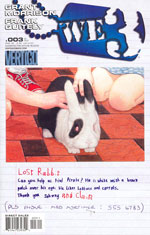
We3 was hyped pre-release by its writer
(someone so famous I’m not going to mention his name) as being “Westernised Manga.” I found this a strange description, not least because, like the crusty old traditionalist I in actuality am, manga is something I’m only s-l-o-w-l-y picking up on. It’s the big thing, apparently, but I didn’t think things like that mattered to our mystery Famous Writer Person (obviously they do but only because he wants that vast audience that manga has, no bad thing). The thing is, it doesn’t just translate manga into a mainstream Western (American) comic book. It takes manga’s
bafflingly lithe and kinetic body, seduces it, pampers it, polishes it,
then rips its guts out and pisses on the carcass.
Every compare/contrast needs a lame-ass duck, and I shall pick Get-Backers
Volume 2, partly because it serves as a typical slice of what the majority
of manga is like, but mostly because it’s the last one my library stocked. Get-Backers is
amusing enough, its bare bones of a plot centering on a duo who specialize in
getting back things that have been stolen. And oh, the hilarious japes they get
up to (yawn). Along the way lots of sharp things happen to sharp people, sharply.
And it’s so similar visually to the rest of Tokypop’s (for it is they) release schedule that it could have been written and drawn in somebody’s
sleep, and probably was.
Reading manga, there’s an obvious and instant homogeneity to them, in aesthetic if not in plot, that makes even the drabbest of Western comics seem like avante-garde experimentalism in comparison. They all look the bloody same. After the western reader gets used to reading from right to left, they then have to contend with the visual language that the Japanese artists employ, and it doesn’t take much effort. In many instances, the artists actually has to write, in letters, the emotion that a character is supposed to be conveying all comics have their little sound effects, occasionally even a comedic ‘swoon!’, but very rarely is the art so bloody bland that they have to tell the reader what the character is feeling, something that should be stark staring obvious in the character’s
expression! Manga therefore draws attention to its own artistic shortcomings,
an unwelcome subversion of the basic principle that visual communication should
be easy to interpret.
Which is where We3 comes in. Pitching itself as ‘Westernised Manga’ initially seems to be doing itself a disfavour. Frank Quitely is one of the relatively and surprisingly few artists working in mainstream comics who has a very definite and unique style, and a painstaking one at that (just ask his editors). His writer has presented him with a script that presents two very obvious problems human characters rarely appear entirely in-panel (glimpsed, for the most part, at angles that hide or conceal them), and a trio of main protagonists who are animals a dog, a cat and a rabbit not
known for being easy to convey subtle emotions with on paper.
The challenge, then, is for Quitely to give himself a Manga-style handicap, working within guidelines that ordinarily would make instantaneous reader communication difficult, but to twist that and, rather than draw attention to the handicap, use it to raise his game, forcing himself to find new ways of working within that, without the Manga cop-out of joining the dots with handy little written appellations over the art.
He does this in a variety of daring ways. The first act of violence we see the We3 animals commit, encased as they are military-issue exoskeletons that have transformed these lovable household pets into hideously effective assassins, is the murder of a South American insurgent, seen from the perspective of a flying blood corpuscle. Quitely delights in presenting hyper-real chunks of ultraviolence that breaks down the barriers of before/during/after to give the reader a multifaceted window open to interpretation. The reader is given all the information they need, to digest at their own speed, in their own ways. Nothing about We3 is obvious.
The defining achievement of the entire 3-issue series takes in the moment where
we get our first full glimpse of the animals. Over a couple of pages we get to
see their jailbreak, depicted over a series of compressed, CCTV-style square
panels. They get to the doors, a woman looks up… and then, gloriously, splashed
triumphantly over two pages, we see them, the animals, leaping free, in mid-air,
glistening in the moonlight, weightless.
It’s an artistic illusion, an evocation of sudden freedom, transcendent motion, that leaves you open-mouthed in pure astonishment. It couldn’t work online, it wouldn’t work as a single piece of exhibited work … the only place it could work is in the grubby low-art bundle of paper called a comic book. Quitely is drawing attention to the showmanship of pure sequential storytelling. He’s
drawing attention to the multiple possibilities of the form.
Like I said. Manga. Ripped-out. Pissed on.
History in the making.
© 2005 David O MacGowan